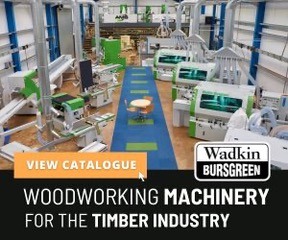The machine was purchased to replace a large, old traditional double-end tenoner that was not only showing signs of wear, but also needed two operators to run it – one to load and the other to unload.
Managing director Brian Kirkpatrick and factory manager Dave Lancaster started their search for a suitable replacement machine earlier this year and contacted several suppliers to see what they could offer.
The brief was that they needed a compact machine that was quick to set, accurate, offer a splinter-free cut and be able to produce a minimum of eight trenched headers per minute with just one operator.
Due to the specific requirements Tonge Bridge had, this immediately meant a number of suppliers were unable to offer a suitable machine. Following detailed discussions with JJ Smith and one other supplier, and after seeing a similar Comec trencher in operation, Brian and Dave decided to order the Comec FRT machine.
Dave comments: “ While the Comec machine we viewed on site was machining a totally different product, we could see straight away that this type of machine could do our job. It was a substantially built piece of equipment which had a very impressive cycle time which was actually quicker than we thought was possible.
“Once a final specification was agreed, Comec produced a detailed 3-D CAD drawing to cover which meant we could clearly see how our machine would function.”
It was specified with a maximum working length capacity of 1000mm (1500 or 2000mm is optional) and an automatic vertical hopper feed with automatic ejection of the machined piece back to the operator.
For machining the trench, one left-hand and one right-hand 2.2kW high speed electro spindles were fitted, along with TCT disposable tip cutter blocks. The movement of the heads was by electro pneumatic cylinders, with hydraulic brake to control the speed.
Both heads were adjustable in the vertical and horizontal positions by screw with mechanical digital readout to enable the notch position and depth to be accurately set.
There was also the facility to adjust the heads so they could machine on the bottom face as well as the top face.
To set the working length the right side was adjustable moving on precision linear guides/bearings with an LCD readout to indicate the position with quick pneumatic locking and release.
Most importantly the working sequence was controlled by PLC meaning once the cutter heads had made the trench they retracted laterally so they did not make a recut on the return stroke.
This action, coupled with the replaceable backing pieces meant that the cut was totally splinter free. To ensure the highest level of operator safety the main machining areas are totally enclosed with electrically interlocked access doors.
Once the machine was complete, Brian and Dave, accompanied by Ian Stanley from JJ Smith, visited the Comec Factory in Italy for acceptance testing which went without a hitch. The machine was delivered on time and has now been installed several months.
Brian Kirkpatrick concludes: “From the outset this project was very professionally handled by both JJ Smith and Comec, with the end result being a machine specified up exactly to suit our specific requirements. It is working very well allowing us to meet the demands of our customers for quality machined door casings.”
The FRT family of machines can be configured differently to suit customers individual production requirements meaning they can be used for other end machining or shaping operations. In addition they can be specified with both top and bottom milling heads and/or vertical drilling units.
T 0151 548 9000








